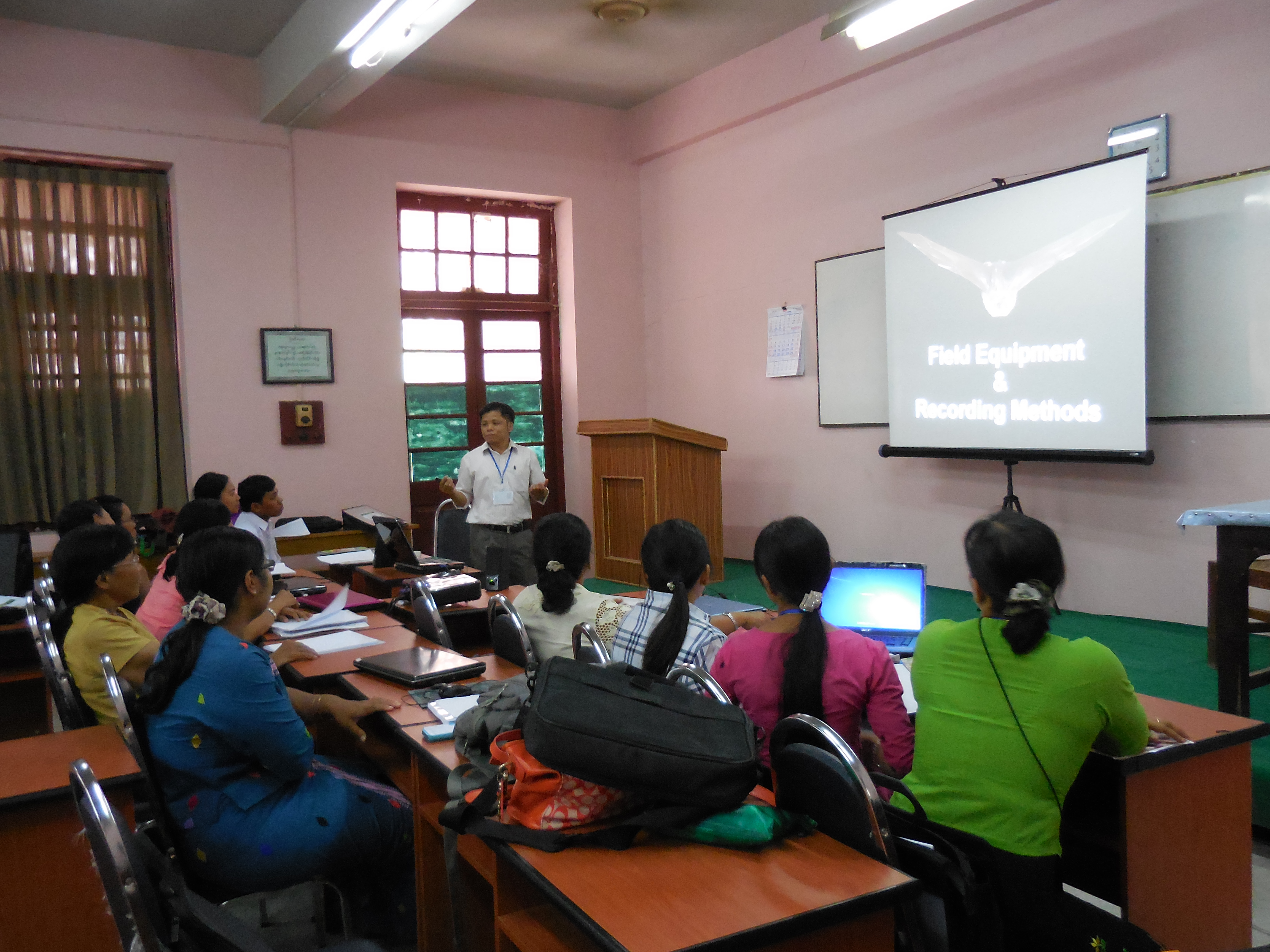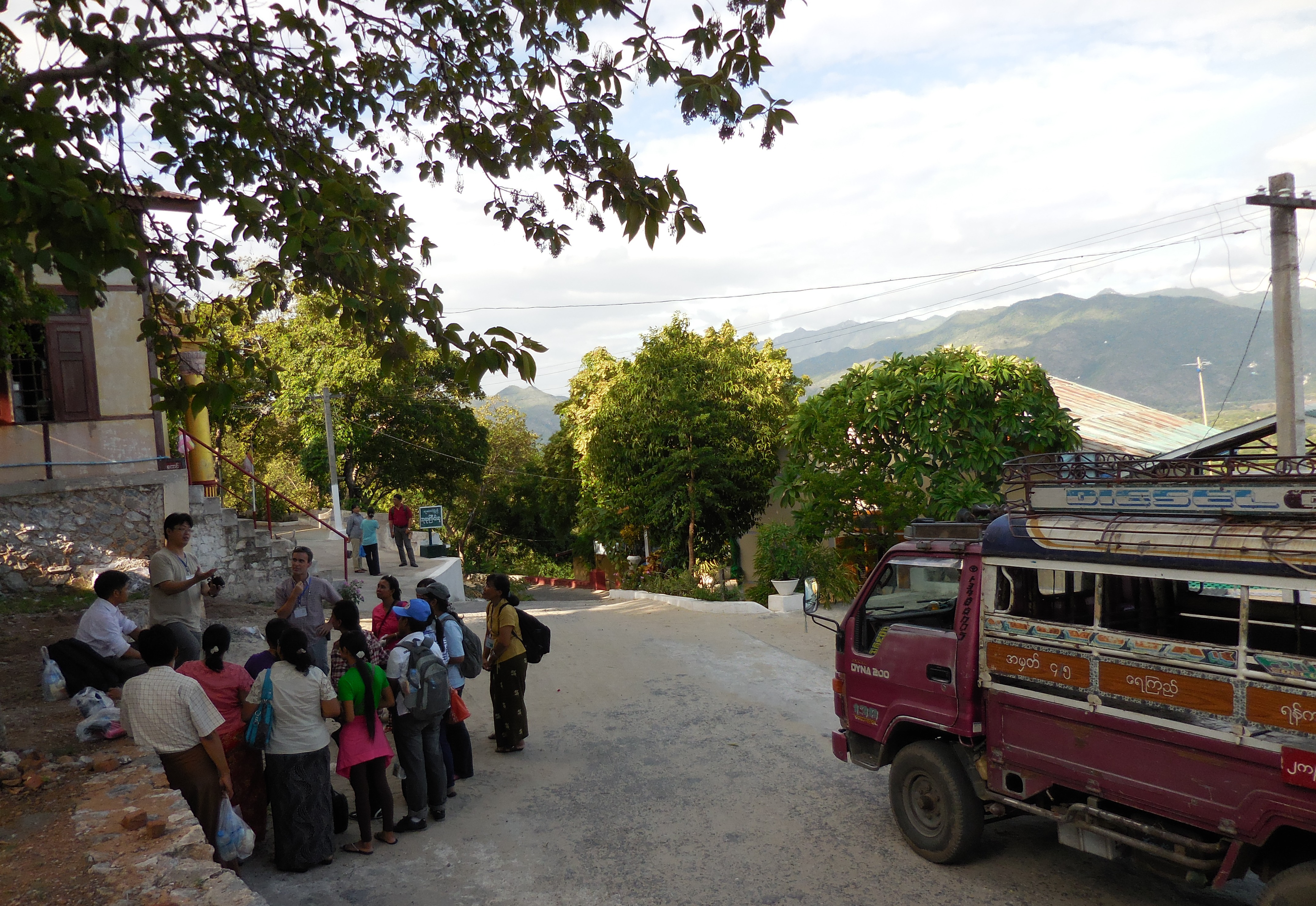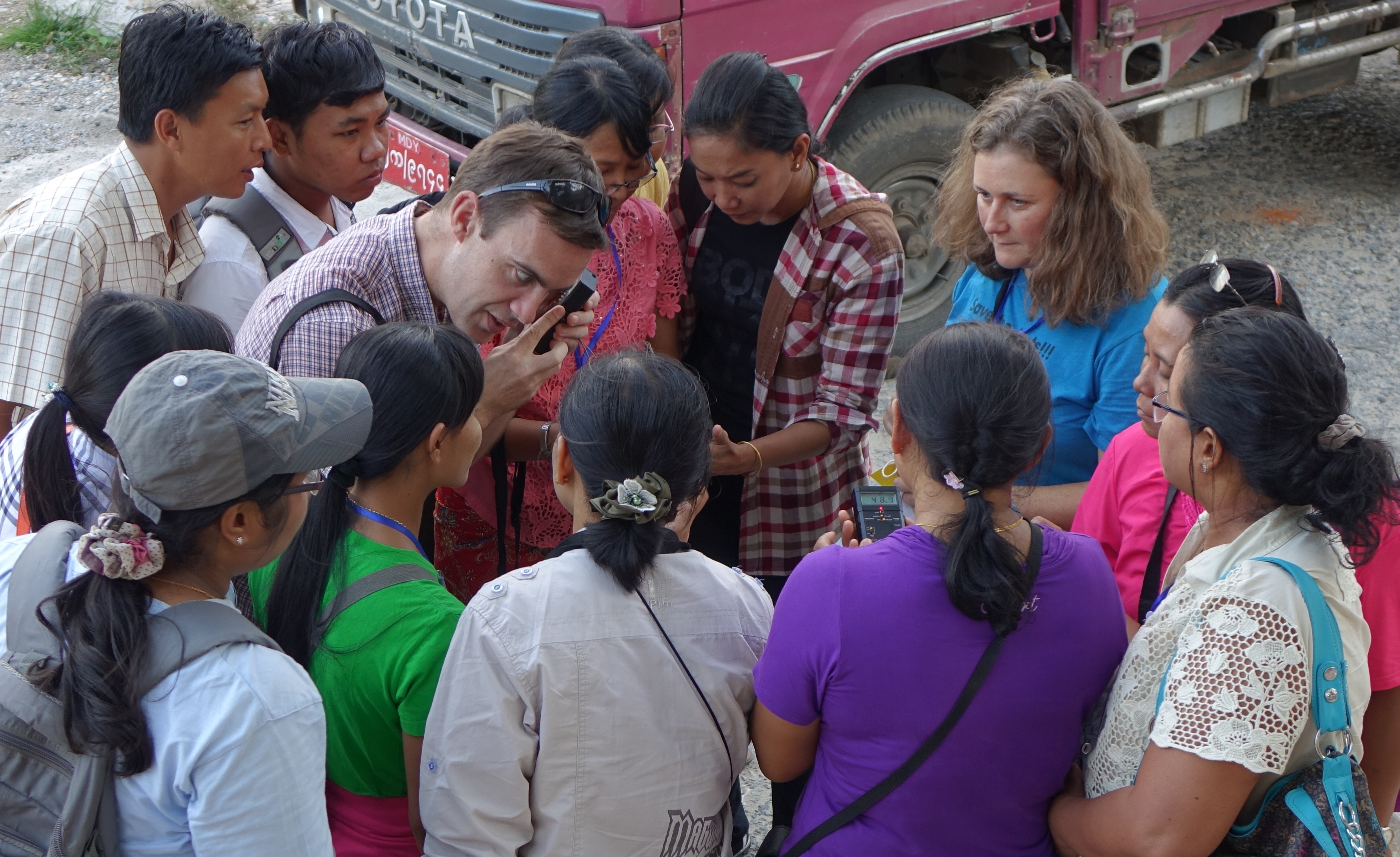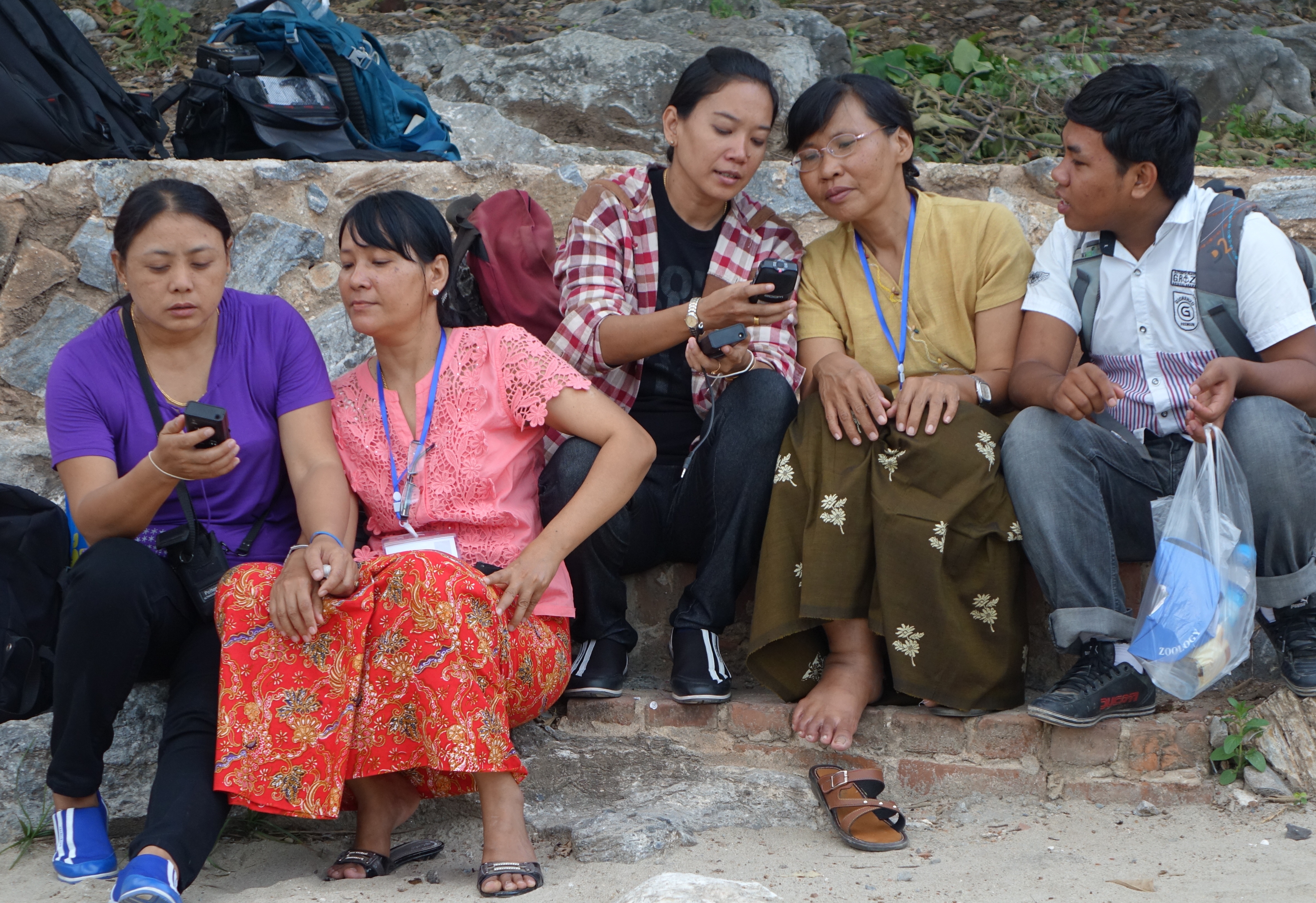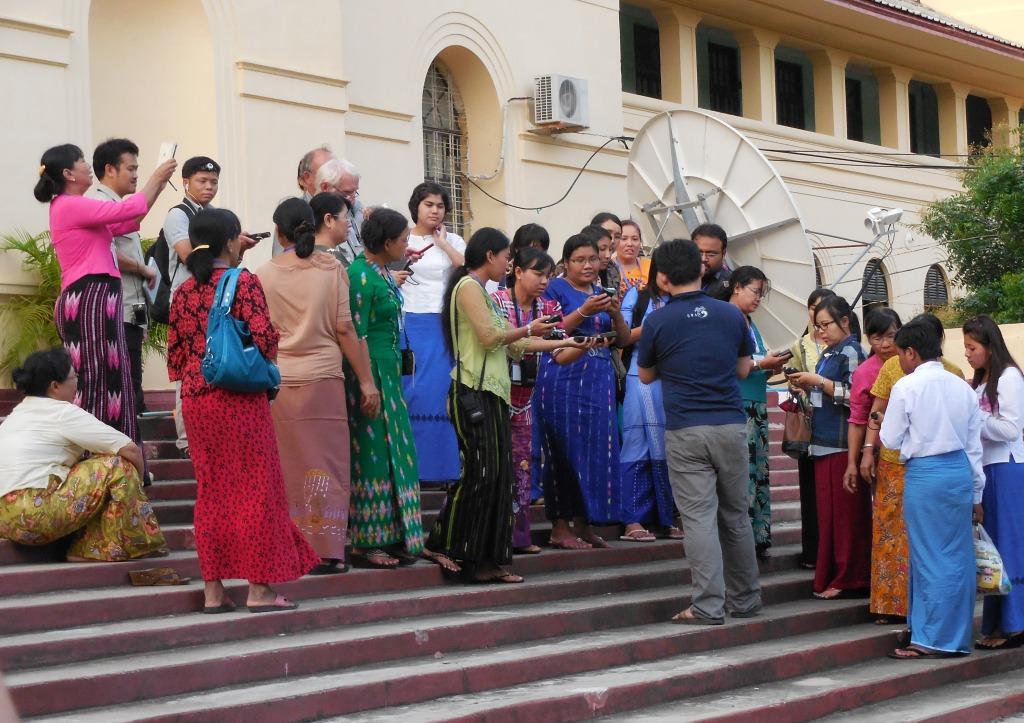Last month the SEABCRU was in Mandalay, Myanmar for the second in its series of Network Gap workshop. Prior capacity-building initiatives by two SEABCRU members of the steering committee (Dr Paul Bates of the Harrison Institute, and Dr Tigga Kingston of Texas Tech University) with the Universities of Mandalay and Yangon (1999-2010) established a generation of Myanmar bat researchers, but political isolation and poor internet communication has precluded their integration and collaboration with researchers in other parts of South East Asia. Myanmar was thus identified as a target location for the “Network Gap” series of SEABCRU workshops by the steering committee in 2012, and as the political situation in Myanmar has changed in the last two years, we were able to initiate this workshop.
The workshop was hosted by the University of Mandalay, Myanmar (Professor Mie Mie Sein, Head of Zoology and Sai Sein Oo Lin, Lecturer University of Bhamo), and was conducted in collaboration with the Harrison Institute (Dr Paul Bates). The workshop was a great success, with 40 participants drawn from 18 universities and colleges across Myanmar. The SEABCRU sponsored 30 participants, with the University of Mandalay finding support for an additional 10 young MSc students.
We also worked hard to raise the profile of bats in Myanmar, and received substantial media coverage, including articles by MRTV (Myanmar Radio & TV), Skynet, The Mirror (national newspaper – Burmese language), Yadanapon (local newspaper — Burmese language) and New Light of Myanmar (national newspaper – Burmese and English editions)
Aims and Objectives:
The global aim of the workshop was to integrate Myanmar researchers into the SEABCRU network. Participants were faculty of Myanmar universities focusing primarily on bats, and who had existing data to publish. In addition, with support from the University of Mandalay, we had ten young MSc students following, who we hope will continue on in bat research. The specific objectives were to:
i) Develop capacity and curatorial skills to establish a national bat collection, hosted at Mandalay University (Taxonomy Group) – despite 15 years of active research on bats there is no national repository for material, hampering taxonomic research and biodiversity studies.
ii) Provide training on echolocation recording and analysis techniques, and discuss studies that can use acoustic survey and monitoring, and the role of acoustics in taxonomy (Acoustics Group)
iii) Initiate a national survey of Pteropus colonies (Flying Fox Group)
iv) Build faculty capacity to publish their research in international journals (Publishing Group) – although there are c. 50 Myanmar bat researchers, there have been only 10 publications in accessible (international or regional) journals, none of which have Myanmar nationals as the first author.
v) Train Myanmar researchers in the use of Darwin Core Format for biodiversity data management, such that they can contribute to the SEABCRU database and generate data compatible with other international repositories (e.g. GBIF).
The five days went incredibly quickly, but we achieved a lot! The full workshop report is soon to follow, but here is a brief summary by group.
Taxonomic & Curatorial Capacity
Lead: Dr Pipat Soisook. Facilitators: Dr Faisal Anwarali Khan, Bounsavane Douangboubpha, Dr Paul Bates, Dr Ibnu Maryanto, Susan Tsang
Objectives:
- develop capacity for a well-curated national collection
- develop a taxonomic network between Myanmar and other SE Asian researchers
- identify potential projects for joint publications
What we did:
During the workshop, we trained 13 participants (10 professors/lecturers with PhD and 3 MSc students) from 9 universities in Myanmar in the best practice for taxonomic data collection, specifically:
- What data need to be collected in the field
- How to set up harp traps and mist-net.
- How to handle bats and take standard external measurements of the bats.
- How to prepare specimens for the collection; e.g. labelling, alcohol, jars.
- How to run and manage collection in long term; e.g. specimens and prepare electronic database.
- What is a loan policy?
We explained how collection and good data are important for taxonomic research and conservation. Group members also exchanged experience about each other’s museums with Myanmar participants e.g. about the location of the museum, when the museum was established, number of specimens in the museum, and problems or challenges during developing the museum. Each of participants shared the information of current situation about collection/specimens in their own university, in which none of them have or started to have their own collection.
The most important activity of the group during the workshop was to revisit the specimen collection of the Department of Zoology, University of Mandalay. As a group, Tax & Sys member swith the participants have initiated the establishment of the bat specimen collection with a name ‘University of Mandalay Zoological Collection (UMZC)’. The head of the department, Professor Dr Mie Mie Sein and Professor Dr Naw Dolly Wilbur will be in charge of the collection. This collection is expected to be the main taxonomic collection in upper Myanmar. This is a promising start for Myanmar’s bat collection as it comprises at least 50 specimens from 18 bat species, including unreported species of Hipposideros lankadiva and H. pratti.
Another major activity of the group members were by pairing up with the participants to work on their unpublished taxonomic/survey data. We expect that from this activity at least 4 papers with great potential to contribute to the Myanmar’s bat taxonomy will be published soon.
Acoustic Surveys
Lead: Dr Tigga Kingston. Facilitators: Joe Chun-Chia Huang, Dr Neil Furey, Dr Vu Dinh Thong.
Objectives:
- to introduce the biology and application of echolocation in studies on bat ecology and taxonomy.
- to make participants familiar with different recording techniques, the use of different detectors in different environments and contexts, and the analysis of recordings for call measurements.
- to provide guidelines in equipment selection, experimental designs for acoustic surveys and monitoring.
- to explain the procedure of reference call library development and the importance for regional research and conservation in bats.
What we did:
The participants comprised eleven Myanmar bat researchers, including ten university lecturers and one masters student.
- three face-to-face lectures on “Echolocation call designs: the role of ecology and taxonomy”, “Bat echolocation calls: description and measurement”, and “Field equipment and recording methods” were given by Dr. Kingston, Dr. Thong, and Huang.
- two in-class trainings on using BatSound Pro software (http://www.batsound.com/) for call description and measurements by Dr. Furey and Huang
- two field training sessions on the use of Pettersson D240X bat detector (http://www.batsound.com/?p=9) for call recording, reference call collection in Yankin Hill, Patheingyi Township, Mandalay and University Mandalay campus.
- Three additional lectures on “echolocation call variations”, “Designs of acoustic survey and monitory”, and “echolocation call library” were designed by Dr. Kingston, Dr. Furey, and Huang were distributed. Additional reference on bat echolocation studies and standard data sheets for call measurements were provided
Data Management
Leads: Danny Squire, Marina Fisher-Phelps
Objectives:
Data Management Objectives:
- Participants understand the importance of data management
- Participants convert existing research data into SEABCRU Darwin Core format
- Participants able to use SEABCRU Darwin Core data collection format in their future research initiatives
- Participants able to instruct others in the use of SEABCRU Darwin Core format
Geographically Information Systems (GIS) Objectives:
- Participants understand the uses of digitally maps in publications and presentations
- Participants understand what a geographic datum is and how it applies to digital mapping and spatial data collection
- Participants format spatial data so that it can be easily loaded into the GIS software DIVA-GIS
- Participants use spatial data to build maps of point data that can be used in publications and presentations
What we did:
The 2014 Data Management and GIS Workshop at Mandalay consisted of instructional presentations by the instructors and hands-on activities for the participants. The participants were instructed in the benefits of having a data management plan and using GIS in their own research and at their universities. Participants learned about the development of the Darwin Core format and how it is used by SEABCRU in data collection and sharing. Participants learned the difference between geographic datums and how to efficiently store spatial coordinates so that they can imported into GIS software. Participants were given the open-source GIS software DIVA-GIS for use during and after the workshop. The participants also created maps using the data collected by the workshop as a whole. Throughout the workshop participants were given hands-on activities so they could practice and demonstrate mastery of the training.
Flying Fox Survey and Monitoring
Lead: Dr Tammy Mildenstein, Facilitators: Prof. Paul Racey, Susan Tsang
Objectives:
The flying fox group focused on the SEABCRU flying fox priority of collating information on current populations and distributions of flying fox species. In conducting the workshop activities, we were able to
a) identify information gaps,
b) identify conservation priorities,
c) collate existing population data of confirmed flying fox roosts,
d) train participants in standardized monitoring protocols and personal protective measures regarding pathogen transmission.
What we did:
Participants comprised 8 post-doctoral professors and 4 M.Sc. students representing 5 universities across Myanmar. We reiterated the importance of monitoring flying fox colonies for conservation, along with why protection of flying foxes should be a priority because of the ecosystem services they provide. We taught the participants the standardized methods for monitoring and assessment common for flying fox colonies. We followed up with hands-on training by visiting a Pteropus giganteus colony two hours drive from Mandalay (Shwe Saydi Pagoda) and gave the participants the opportunity to practice both direct and emergence counts. While at the site, an overview of personal protective equipment was given and each participant was familiarized with why this is important to prevent pathogen transmission. After reassembling in the classroom the following day, we analyzed the data as a group for a finalized population estimate. Using the data collected from the participants, we demonstrated common sources of variance and discussed how that may affect trend detection. We were able to determine that the Shwe Saydi population has declined in the past decade by comparing the count data we took to data available from the dissertation of one of the participants (Moe Moe Aung, 2006), either due to increased human activity or displacement of bats by birds at the pagoda. The participants were thus able to have a real example of how historical information about the site can add value to the study and provide keener insight on flying fox population trends. We had the participants recap what they had learned at the end of the workshop.
In a session that involved participants from all working groups, we asked for information to help create a list of reported flying fox roost sites around Myanmar, which were primarily clustered around either the Mandalay-Sagaing Region or in areas near Yangon (Fig. 8). Very little information is available about the status of flying fox roosts in more remote areas such as Kachin. Many of the roost sites indicated had not been confirmed, and provide opportunities for projects for M.Sc. students.
Publishing In Regional and International Journals
Lead Dr. Neil Furey. Facilitators Dr Dave Lane, Dr Zubaid Akbar, all attendant steering committee.
Objectives:
The majority of participants have already written research theses at Myanmar universities, and obtained their M.Sc. or Ph.D. degrees, but none have published their work in major international Journals. Acceptance of publications will raise the profile of Myanmar bat research and conservation activities both locally and internationally. An additional benefit/outcome anticipated from this internationalization exercise is the development of collaborative relationships and possible linking in to grant-giving bodies for future research proposals. The objectives of this section were thus:
- To explain the scientific publishing process
- To demonstrate how a scientific paper is written by actually preparing articles using real data collected by each participant
What we did:
Participants were first asked to describe the bat research data sets they had generated through prior work (available as dissertations and theses, but not published). They were then matched to members of the steering committee with similar interests and experience. These steering committee members then acted as mentors, working one-on-one or in pairs or small groups, through practical exercises. In these exercises, basic outlines of each part of a publication were introduced, and then the pairs/groups prepared bullet point summaries of each section based on their own data.
At the end of the day and a half, the participants each presented a summary of the draft paper outline. Participants will work with their mentors to prepare full drafts within three months, with the deadline for submission to an international journal set at 6 months.
And here is an album of participants and facilitators. Thank you to everyone for working so hard together to make the workshop a success!! It is so exciting to have bat researchers from Myanmar joining the SEABCRU.


















